Beef mami is one of the favorite Chinese food among Pinoys and maybe the reason why Chowking is so popular. There are many version of mami soup like chicken or wonton but beef mami is the tastiest of them all. This beef mami dish is simple to make and requires only a few minutes to prepare. The cooking time is also not that long, but because beef is tougher than chicken or pork, it requires longer time to tenderize.
It will depend on which part of the beef you will use. Briskets or flank requires less than an hour to tenderize but if you will use a pressure cooker, it will only take half an hour. You can also use other beef parts like ribs or tenderloin but if you ask me, my favorite part are those with lots of connective tissues with a rubbery texture.
A Comforting Bowl of Homemade Beef Mami
Growing up in the Philippines, a steaming bowl of beef noodle soup was something my family and I always looked forward to, especially on rainy days. My uncle, who lived in Binondo, Manila’s Chinatown, was the one who introduced me to this dish. He would always say, “The secret to a good mami is in the broth,” and I couldn’t agree more. The rich, flavorful soup, the tender beef, and the chewy noodles — it was a complete meal that instantly brought warmth and comfort.
While there are various versions of mami like chicken or wonton, there’s something about this beef version that stands out. Maybe it’s the deep, savory broth or the satisfying texture of the meat, but this soup has a way of making you feel like you’re wrapped in a cozy blanket. It’s no wonder beef noodle soup has become a staple in many Filipino homes, and of course, a favorite offering at Chowking, one of the most popular fast-food chains in the Philippines.
A Hearty Dish with a Chinese Influence
Beef noodle soup is a dish with strong Chinese roots, and it’s easy to see how it found its way into the hearts of Filipinos. The dish was brought over by Chinese immigrants and has since evolved into a comfort food that’s become a part of everyday Filipino cuisine. Mami stalls popped up all over Manila, and soon enough, it became a regular part of street food culture.
The name “mami” itself is said to be derived from the Chinese words “ma” (meat) and “mi” (noodles), reflecting its simple yet hearty ingredients. Over the years, this humble soup has become so much more than just a street food favorite — it’s now a dish that many families love to make at home, especially during the cooler months.
Choosing the Right Cut for a Perfect Broth
One thing I’ve learned from my uncle’s cooking wisdom is that the choice of beef cuts can make or break your mami experience. My personal favorite is beef brisket. It has the right balance of meat and fat, and when simmered slowly, it becomes incredibly tender while also imparting a rich flavor to the broth. But if you’re pressed for time, using a pressure cooker will speed up the process, cutting the simmering time in half.
There are, of course, other beef cuts you can experiment with. My sister, who recently visited Cebu and tasted their local version of beef noodle soup, swears by using beef ribs for an extra robust flavor. Meanwhile, another cousin prefers tenderloin because it’s leaner and cooks faster. For me, though, it’s the cuts with lots of connective tissue that bring out the most flavor — the kind that gets soft and gelatinous after a long simmer. That’s where the magic happens.
Crafting the Perfect Broth
Creating a delicious broth for this dish may seem intimidating, but it’s actually straightforward. One of the key ingredients that adds depth to the soup is star anise, a spice that brings a sweet, licorice-like aroma. It’s subtle but noticeable, and it helps balance the savory notes of the beef.
To start, you sauté garlic and onions to create a flavorful base. Then you add the beef and let it brown just a little before pouring in water to start the simmering process. The star anise, along with salt, pepper, and a beef cube, go in next. As the soup simmers, a layer of scum might form on top, which you’ll want to skim off to keep the broth clear and clean-tasting.
This simmering process, though simple, is where the flavor develops. I often cover the pot, lower the heat, and let it do its thing for about 45 minutes. The aroma of the broth filling the kitchen always takes me back to Sunday afternoons at my grandma’s house, where a big pot of beef noodle soup would be simmering away while we all caught up on family news.
Assembling the Bowl
Once the broth is ready and the beef is tender, the fun part begins: assembling the bowl. This is where you can get creative with the toppings. I like to start with egg noodles — or miki noodles, as we call them — because they have a slight chew that pairs well with the beef. Some people prefer the thinner Canton-style noodles, but for me, the texture of the miki is just perfect.
Chinese cabbage, also known as pechay Baguio, goes in next. The slightly bitter greens help cut through the richness of the broth, adding a fresh element to the dish. Then, of course, there are the garnishes — sliced hard-boiled eggs and a sprinkling of chopped spring onions. These not only add color to the dish but also enhance the flavor.
When everything is put together, the result is a bowl that’s hearty, flavorful, and satisfying. Each spoonful is a reminder of how simple ingredients can come together to create something special.
A Dish to Warm the Soul
What I love most about this noodle soup is how it brings people together. In my family, it’s more than just a dish; it’s a reminder of our shared memories, of the afternoons spent around the table enjoying a meal that warms both the body and soul. Whether you’re making it for yourself or serving it to loved ones, this dish is sure to bring comfort and joy to everyone who takes a bite.
So, the next time you’re in the mood for something warm and comforting, give this recipe a try. It’s an easy way to bring a little bit of nostalgia to your kitchen, and who knows — it might just become your family’s new favorite.
How to Cook Beef Mami
Ingredients
- 1 kilo beef flank or briskets, sliced into cubes or strips
- 10 pcs star anise
- 1 pc beef cube
- 10 cups water
- 3 Tbsp. cooking oil
- 1/2 head garlic minced
- 1 large red onion chopped
- 800 grams miki or egg noodles cooked
- 1/2 head Chinese cabbage chopped
- 6 pcs hard boiled eggs peeled and sliced
- salt and pepper to taste
- spring onions for garnishing
- fried garlic for garnishing optional
Instructions
How to Cook Beef Mami
- In a medium size pot, heat oil and saute garlic until fragrant. Then add onion and saute until soft.
- Then put in the beef and saute until it becomes light brown. Add water, star anise, beef cube, salt and pepper and bring to a boil. Remove scum that floats on the broth.
- Cover and simmer for about 45 minutes or until the beef is tender.
- In a serving bowl, arrange and place the chopped Chinese cabbage and egg noodles or miki.
- Pour some broth on the bowl just enough to cover the egg noodles and some pieces of beef. Garnish with sliced hard boiled eggs and spring onions. Serve hot.
Notes
Cooking Tips:
Use the Right Beef Cut for Maximum Flavor
For a deeply flavorful broth, choose cuts like beef brisket or shank, which have a good balance of meat and fat. These cuts become tender after slow cooking, releasing rich flavors into the soup. If you want to save time, a pressure cooker can help tenderize tougher cuts in half the usual time.Skim the Broth for a Cleaner Taste
As the beef simmers, impurities will rise to the surface, forming a layer of scum. Be sure to skim this off regularly to keep your broth clear and prevent any unwanted bitterness. This simple step makes a big difference in achieving a cleaner, more refined taste.Add Toppings Just Before Serving
To preserve the freshness and crunch of your toppings, like Chinese cabbage and spring onions, add them just before serving. This keeps the vegetables from becoming too soggy and ensures a satisfying texture. Also, if using hard-boiled eggs, slice them and place on top to create a visually appealing finish.






Hi Nelson, I’m glad you liked the recipe! Thanks for your kind words!
Hi, Manny…your beef Mami tastes much way better than Chowking’s Al Khobar Mami.
Thanks for the recipes.